Feng Shu
Fellow, IEEE
Millimeter-Wave Position Sensing Using Reconfigurable Intelligent Surfaces: Positioning Error Bound and Phase Shift Configuration
Aug 09, 2025Abstract:Millimeter-wave (mmWave) positioning has emerged as a promising technology for next-generation intelligent systems. The advent of reconfigurable intelligent surfaces (RISs) has revolutionized high-precision mmWave localization by enabling dynamic manipulation of wireless propagation environments. This paper investigates a three-dimensional (3D) multi-input single-output (MISO) mmWave positioning system assisted by multiple RISs. We introduce a measurement framework incorporating sequential RIS activation and directional beamforming to fully exploit virtual line-of-sight (VLoS) paths. The theoretical performance limits are rigorously analyzed through derivation of the Fisher information and subsequent positioning error bound (PEB). To minimize the PEB, two distinct optimization approaches are proposed for continuous and discrete phase shift configurations of RISs. For continuous phase shifts, a Riemannian manifold-based optimization algorithm is proposed. For discrete phase shifts, a heuristic algorithm incorporating the grey wolf optimizer is proposed. Extensive numerical simulations demonstrate the effectiveness of the proposed algorithms in reducing the PEB and validate the improvement in positioning accuracy achieved by multiple RISs.
AI-empowered Channel Estimation for Block-based Active IRS-enhanced Hybrid-field IoT Network
May 20, 2025Abstract:In this paper, channel estimation (CE) for uplink hybrid-field communications involving multiple Internet of Things (IoT) devices assisted by an active intelligent reflecting surface (IRS) is investigated. Firstly, to reduce the complexity of near-field (NF) channel modeling and estimation between IoT devices and active IRS, a sub-blocking strategy for active IRS is proposed. Specifically, the entire active IRS is divided into multiple smaller sub-blocks, so that IoT devices are located in the far-field (FF) region of each sub block, while also being located in the NF region of the entire active IRS. This strategy significantly simplifies the channel model and reduces the parameter estimation dimension by decoupling the high-dimensional NF channel parameter space into low dimensional FF sub channels. Subsequently, the relationship between channel approximation error and CE error with respect to the number of sub blocks is derived, and the optimal number of sub blocks is solved based on the criterion of minimizing the total error. In addition, considering that the amplification capability of active IRS requires power consumption, a closed-form expression for the optimal power allocation factor is derived. To further reduce the pilot overhead, a lightweight CE algorithm based on convolutional autoencoder (CAE) and multi-head attention mechanism, called CAEformer, is designed. The Cramer-Rao lower bound is derived to evaluate the proposed algorithm's performance. Finally, simulation results demonstrate the proposed CAEformer network significantly outperforms the conventional least square and minimum mean square error scheme in terms of estimation accuracy.
Secure Directional Modulation with Movable Antenna Array Aided by RIS
Apr 10, 2025



Abstract:In this paper, to fully exploit the performance gains from moveable antennas (MAs) and reconfigurable intelligent surface (RIS), a RIS-aided directional modulation \textcolor{blue}{(DM)} network with movable antenna at base station (BS) is established Based on the principle of DM, a BS equipped with MAs transmits legitimate information to a single-antenna user (Bob) while exploiting artificial noise (AN) to degrade signal reception at the eavesdropper (Eve). The combination of AN and transmission beamforming vectors is modeled as joint beamforming vector (JBV) to achieve optimal power allocation. The objective is to maximize the achievable secrecy rate (SR) by optimizing MAs antenna position, phase shift matrix (PSM) of RIS, and JBV. The limited movable range (MR) and discrete candidate positions of the MAs at the BS are considered, which renders the optimization problem non-convex. To address these challenges, an optimization method under perfect channel state information (CSI) is firstly designed, in which the MAs antenna positions are obtained using compressive sensing (CS) technology, and JBV and PSM are iteratively optimized. Then, the design method and SR performance under imperfect CSI is investigated. The proposed algorithms have fewer iterations and lower complexity. Simulation results demonstrate that MAs outperform fixed-position antennas in SR performance when there is an adequately large MR available.
Which Channel in 6G, Low-rank or Full-rank, more needs RIS?
Dec 04, 2024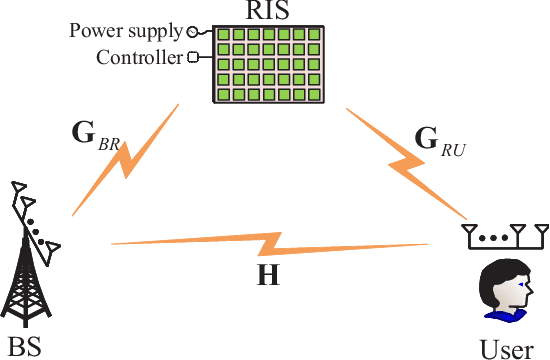



Abstract:Reconfigurable intelligent surface (RIS), as an efficient tool to improve receive signal-to-noise ratio, extend coverage and create more spatial diversity, is viewed as a most promising technique for the future wireless networks like 6G. As you know, RIS is very suitable for a special wireless scenario with wireless link between BS and users being completely blocked, i.e., no link. In this paper, we extend its applications to a general scenario, i.e., rank-deficient channel, particularly some extremely low-rank ones such as no link, and line-of-sight (LoS, rank-one). Actually, there are several potential important low-rank applications like low-altitude, satellite, UAV, marine, and deep-space communications. In such a situation, it is found that RIS may make a dramatic degrees of freedom (DoF) enhancement over no RIS. By using a distributed RISs placement, the DoF of channel from BS to user in LoS channel may be even boosted from a low-rank like 0/1 to full-rank. This will achieve an extremely rate improvement via spatial parallel multiple-stream transmission from BS to user. In this paper, we present a complete review of making an in-depth discussion on DoF effect of RIS.
Which Channel, Low-rank or Full-rank, more needs RIS?
Nov 21, 2024



Abstract:RIS, as an efficient tool to improve receive signal-to-noise ratio, extend coverage and create more spatial diversity, is viewed as a most promising technique for the future wireless networks like 6G. As you know, IRS is very suitable for a special wireless scenario with wireless link between BS and users being completely blocked. In this paper, we extend its applications to a general scenario, i.e., rank-deficient-channel, particularly some extremely low-rank ones such as no link, and line-of-sight (LoS). Actually, there are several potential important low-rank applications of like satellite, UAV communications, marine, and deep-space communications. In such a situation, it is found that RIS may make a dramatic DoF enhancement over no RIS. By using a distributed RIS placement, the DoF of channels from BS to users may be even boosted from a low-rank like 0/1 to full-rank. This will achieve an extremely rate improvement via multiple spatial streams transmission per user. In this paper, we present a complete review of make a in-depth discussion on DoF effect of RIS.
DoF Analysis and Beamforming Design for Active IRS-aided Multi-user MIMO Wireless Communication in Rank-deficient Channels
Nov 13, 2024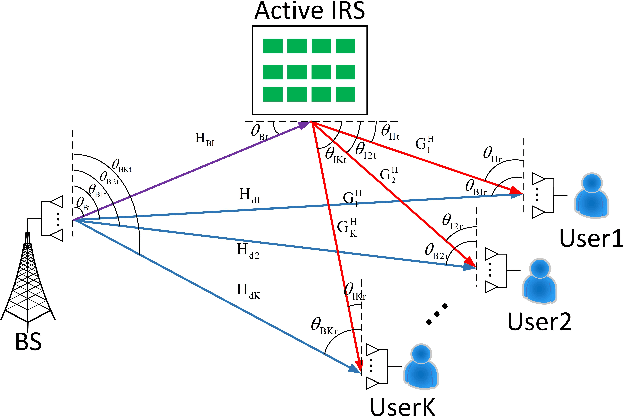
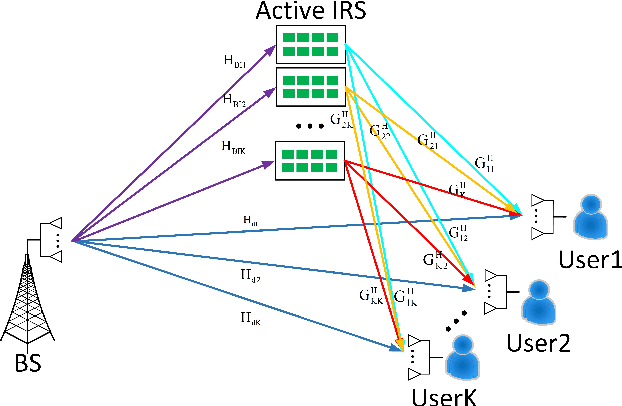
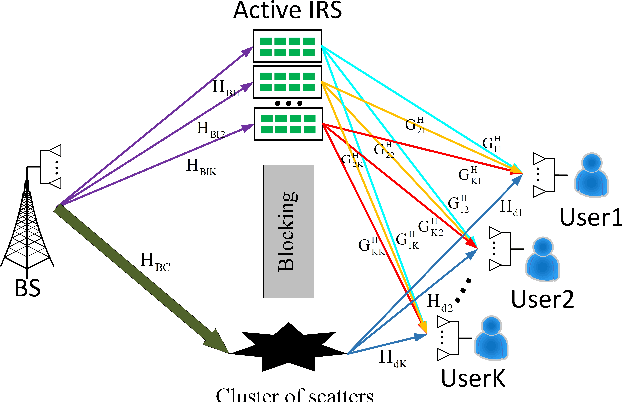
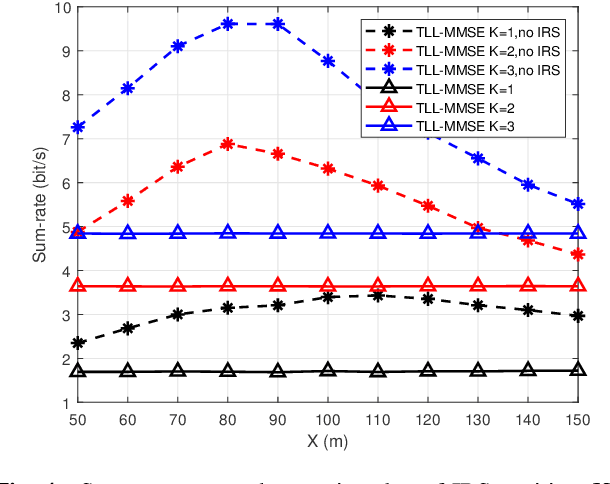
Abstract:Due to its ability of significantly improving data rate, intelligent reflecting surface (IRS) will be a potential crucial technique for the future generation wireless networks like 6G. In this paper, we will focus on the analysis of degree of freedom (DoF) in IRS-aided multi-user MIMO network. Firstly, the DoF upper bound of IRS-aided single-user MIMO network, i.e., the achievable maximum DoF of such a system, is derived, and the corresponding results are extended to the case of IRS-aided multiuser MIMO by using the matrix rank inequalities. In particular, in serious rank-deficient, also called low-rank, channels like line-of-sight (LoS), the network DoF may doubles over no-IRS with the help of IRS. To verify the rate performance gain from augmented DoF, three closed-form beamforming methods, null-space projection plus maximize transmit power and maximize receive power (NSP-MTP-MRP), Schmidt orthogonalization plus minimum mean square error (SO-MMSE) and two-layer leakage plus MMSE (TLL-MMSE) are proposed to achieve the maximum DoF. Simulation results shows that IRS does make a dramatic rate enhancement. For example, in a serious deficient channel, the sum-rate of the proposed TLL-MMSE aided by IRS is about twice that of no IRS. This means that IRS may achieve a significant DoF improvement in such a channel.
Multi-modal Iterative and Deep Fusion Frameworks for Enhanced Passive DOA Sensing via a Green Massive H2AD MIMO Receiver
Nov 11, 2024



Abstract:Most existing DOA estimation methods assume ideal source incident angles with minimal noise. Moreover, directly using pre-estimated angles to calculate weighted coefficients can lead to performance loss. Thus, a green multi-modal (MM) fusion DOA framework is proposed to realize a more practical, low-cost and high time-efficiency DOA estimation for a H$^2$AD array. Firstly, two more efficient clustering methods, global maximum cos\_similarity clustering (GMaxCS) and global minimum distance clustering (GMinD), are presented to infer more precise true solutions from the candidate solution sets. Based on this, an iteration weighted fusion (IWF)-based method is introduced to iteratively update weighted fusion coefficients and the clustering center of the true solution classes by using the estimated values. Particularly, the coarse DOA calculated by fully digital (FD) subarray, serves as the initial cluster center. The above process yields two methods called MM-IWF-GMaxCS and MM-IWF-GMinD. To further provide a higher-accuracy DOA estimation, a fusion network (fusionNet) is proposed to aggregate the inferred two-part true angles and thus generates two effective approaches called MM-fusionNet-GMaxCS and MM-fusionNet-GMinD. The simulation outcomes show the proposed four approaches can achieve the ideal DOA performance and the CRLB. Meanwhile, proposed MM-fusionNet-GMaxCS and MM-fusionNet-GMinD exhibit superior DOA performance compared to MM-IWF-GMaxCS and MM-IWF-GMinD, especially in extremely-low SNR range.
Enhanced channel estimation for near-field IRS-aided multi-user MIMO system via deep residual network
Oct 28, 2024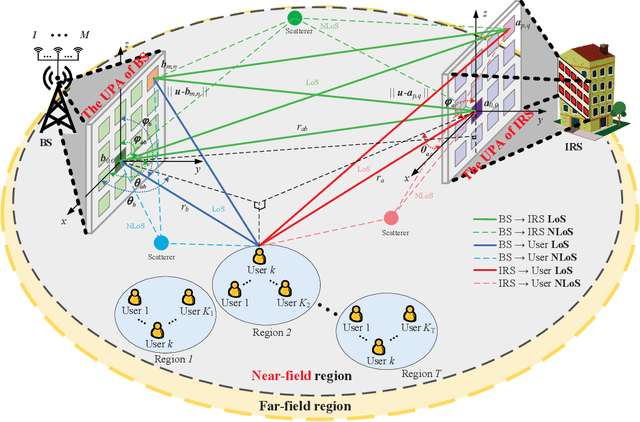

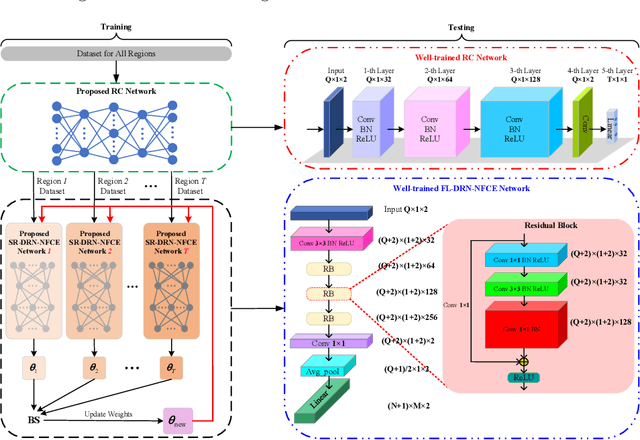
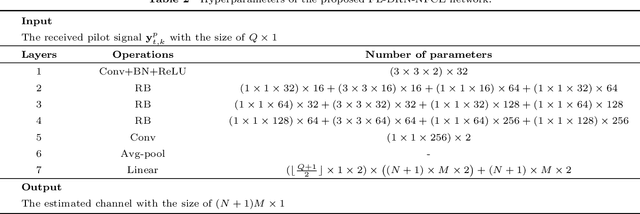
Abstract:In this paper, channel estimation (CE) of intelligent reflecting surface aided near-field (NF) multi-user communication is investigated. Initially, the least square (LS) estimator and minimum mean square error (MMSE) estimator for the estimated channel are designed, and their mean square errors (MSEs) are derived. Subsequently, to fully harness the potential of deep residual networks (DRNs) in denoising, the above CE problem is reconceptualized as a denoising task, and a DRN-driven NF CE (DRN-NFCE) framework is proposed, and the Cram$\acute{e}$r-Rao lower bound (CRLB) is derived to serve as a benchmark for performance evaluation. In addition, to effectively capture and leverage these diverse channel features, a federated learning (FL) based global DRN-NFCE network, namely FL-DRN-NFCE, is constructed through collaborative training and joint optimization of single region DRN-NFCE (SR-DRN-NFCE) networks in different user regions. Here, users are divided into multiple regions. Correspondingly, a user region classifier based on convolutional neural network is designed to achieve the goal of matching datasets from different user regions to the corresponding SR-DRN-NFCE network. Simulation results demonstrate that the proposed FL-DRN-NFCE framework outperforms LS, MMSE, and no residual connections in terms of MSE, and the proposed FL-DRN-NFCE method has higher CE accuracy over the SR-DRN-NFCE method.
Direction Modulation Design for UAV Assisted by IRS with discrete phase shift
Oct 07, 2024
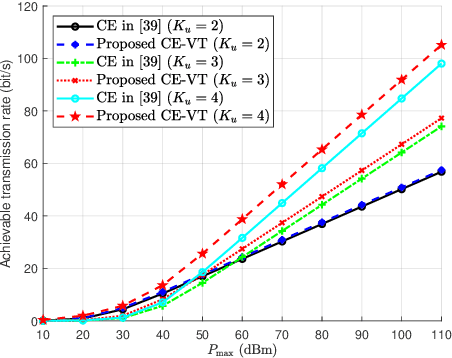
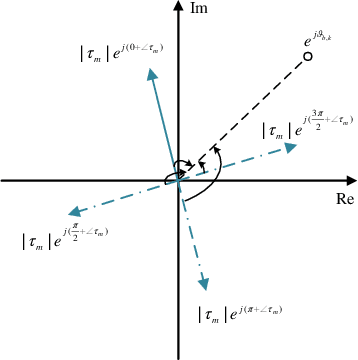

Abstract:As a physical layer security technology, directional modulation (DM) can be combined with intelligent reflect-ing surface (IRS) to improve the security of drone communications. In this paper, a directional modulation scheme assisted by the IRS is proposed to maximize the transmission rate of unmanned aerial vehicle (UAV) secure communication. Specifically, with the assistance of the IRS, the UAV transmits legitimate information and main-tains its constellation pattern at the location of legitimate users on the ground, while the constellation pattern is disrupted at the eavesdropper's location. In order to solve the joint optimization problem of digital weight coefficients, UAV position, and IRS discrete phase shift, firstly, the digital weight vector and UAV position are optimized through power minimization. Secondly, three methods are proposed to optimize IRS phase shift, namely vector trajectory (VT) method, cross entropy vector trajectory (CE-VT) algorithm, and block coordinate descent vector trajectory (BCD-VT) algorithm. Compared to traditional cross entropy (CE) methods and block coordinate descent (BCD) methods, the proposed CE-VT and BCD-VT algorithms can improve transmission rate performance. The numerical results validate the effectiveness of the optimization scheme in IRS assisted UAV communication.
Enhanced DOA Estimation via Hybrid Massive MIMO Receive Array with Switches-based Sparse Architecture
Sep 22, 2024


Abstract:Hybrid massive arrays have been widely used in direction of arrival (DOA) estimation for it can provide larger aperture with lower hardware complexity. However, as the signals received by a hybrid array are compressed by the phase shifter network or the switch network, the degree of freedom (DOF) or spatial resolution of hybrid array is lower than fully-digital (FD) array with same number of antennas. Therefore, we develop a novel sparse hybrid array called switches-based sparse hybrid array (SW-SHA) which by combining nested array and switches-based hybrid array to achieve a huge improvement on DOF over traditional hybrid arrays. Simulations of the spatial spectrums verify that SW-SHA can accurately solve the problem of DOA estimation with the number of signal sources much larger than the number of RF chains. Finally, to further improve the accuracy of DOA estimation for SW-SHA, MMV-SW-SHA is proposed by transforming the single-snapshot co-array signal into MMV form. The simulation results also show that MMV-SW-SHA has better performance than SW-SHA when signal-to-noise ratio (SNR) is low.
 Add to Chrome
Add to Chrome Add to Firefox
Add to Firefox Add to Edge
Add to Edge